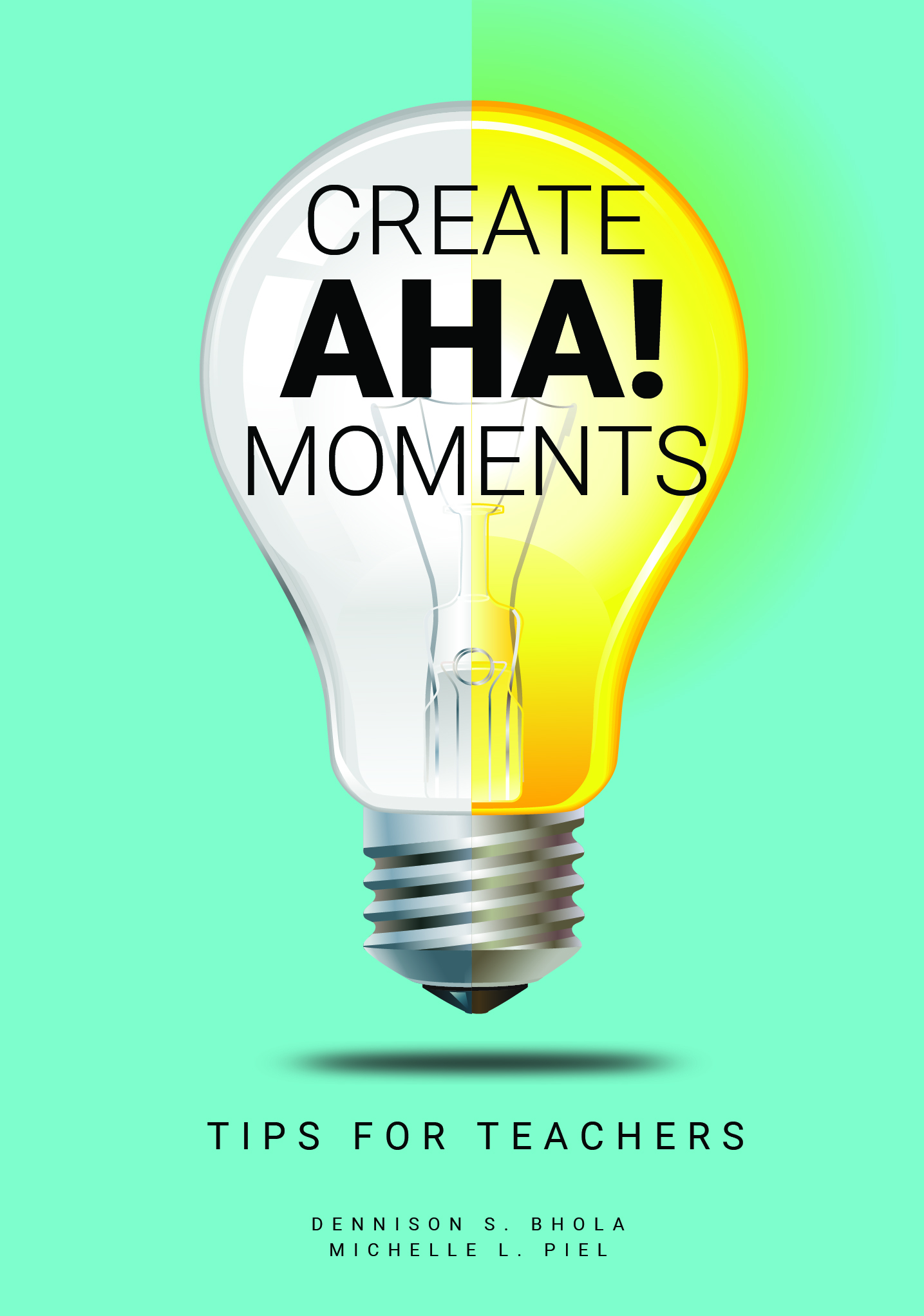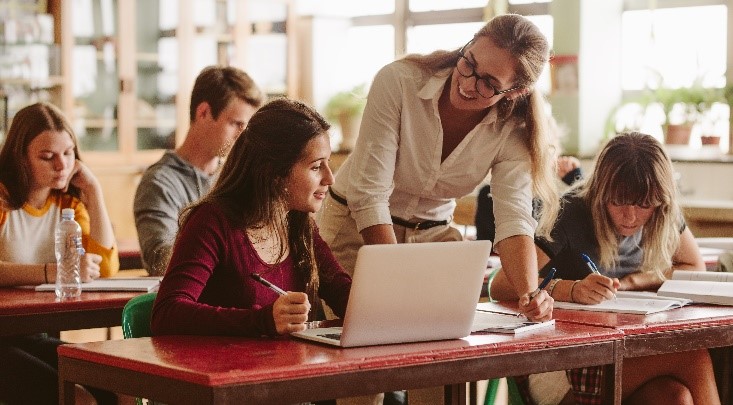
This is an excerpt from our new book, Create AHA! Moments, Tips for Teachers. For more information, check out the book’s website here.
- What is guided practice? When is it used?
- Why is guided practice essential to learning?
- Why it is necessary to prepare for guided practice?
- What are some things to consider when formulating a set of learning activities for use during guided practice?
- What do I need to do during guided practice?
- I know my subject matter pretty well, so why do I need to prepare questions and explanations for guided practice?
- How can guided practice be used to identify and facilitate teachable moments?
What is guided practice? When is it used?
During a lesson, guided practice provides students with an opportunity to demonstrate understanding and apply new information immediately after instruction while their teacher is available to help them learn. Guided practice provides teachers with an opportunity to observe students’ performances and nip errors in the bud before incorrect reasoning or confusion can take root.

Why is guided practice essential to learning?
To develop correct reasoning, there needs to be a coordinated effort between teacher and student. As an illustration, consider how novice swimmers benefit from practicing under the guidance of an instructor when learning how to swim the front crawl stroke. Similarly, classroom students benefit from receiving immediate feedback and making corrections based on what their teacher observes them doing. Like swimmers, learners are adapting to many factors as they practice, i.e., direction and distance to the goal, depth, complexity, actions, cause & effect, and risk of failure. Therefore, before investing too much effort learners naturally consider: “If I flail, is someone here to help me?” Ideally that person is a “more knowledgeable other” who can serve as a guide—like a teacher, parent, or tutor—to help the student straighten things out.
During guided practice, the message from the teacher to the learner is: I am willing to help you, but for you to reap the greatest benefit, you need to do the work yourself. The student needs to invest learning time. Like a swimmer taking swim lessons, the student has to intentionally put forth effort. This effort is an investment of energy that demonstrates the learner’s commitment to learn and that she values the information. The student’s performance allows the teacher to see a demonstration of what the learner can do as well as where she is struggling. Through observation of the student at work the teacher can see what the student knows and understands before providing an explanation or feedback to help her close the performance gap.

Why it is necessary to prepare for guided practice?
You know the adage: “to be forewarned is to be forearmed.” Advance preparation allows you a cognitive cushion of preparedness. When students spring questions on you, you can remain calm and smile to yourself as you share well-prepared, clear explanations and activities out of your “tool bag” to deepen understanding and create “Aha! Moments”.
To make the best use of guided practice time with students, it is extremely helpful to prepare in advance. It makes sense to do this during lesson planning. The primary reason for advanced preparation is to have time to craft questions and activities that will make learning errors “visible” during guided practice time.
As you develop questions and activities for guided practice, consider common errors and prepare clear explanations designed to help students identify any errors and understand correct reasoning. To ensure deep thinking, design questions that connect new knowledge and the student’s relevant prior knowledge to the maximum extent possible as this will strengthen neural pathways for correct reasoning and make the lesson more memorable.
What are some things to consider when formulating a set of learning activities for use during guided practice?
- The lesson objectives from your curriculum document
- The main learning points your will cover with this lesson
- Useful terminology to post as “new vocabulary”
- Connections you want to make with the learners’ relevant prior knowledge, interests, age and life context
- Carefully designed questions which can produce visible evidence of correct or incorrect reasoning
- Clear answers, analogies, metaphors and demonstrations which illustrate evidence of correct reasoning and/or skill
- Common errors and how to spot them; how you will monitor student’s work.
- What to include in your teaching tool bag for this guided practice session: Thoughtful explanations, correct reasoning, concrete examples, and live and pre-recorded performance demos that you could use to illustrate perfect performance
- Feedback to help learners recognize gaps and actions students can follow to close any knowledge gaps

What do I need to do during guided practice?
During guided practice utilize thoughtfully chosen activities that reveal errors. Be observant. When you see that a student needs guidance, compassionately help the student identify the knowledge gap and understand correct reasoning versus incorrect reasoning. Then, ensure the student can demonstrate the correct reasoning or skill—effectively closing the gap. Your main goal during guided practice is to ensure students can consistently demonstrate correct reasoning to meet their target learning outcomes while developing students’ competence and confidence.

I know my subject matter pretty well, so why do I need to prepare questions and explanations for guided practice?
Preparing for guided practice is essential because then you can focus on observing students to see small changes in their expressions and body language that indicate when one of them needs your help. Your state of readiness means that during guided practice, your tool bag is stocked with further examples, explanations, and learning activities that make sense for learners to use for relevant, meaningful practice. A huge benefit of this is that your students’ trust in you will grow as they observe you welcoming their errors and helping them correct their reasoning! Simultaneously, their confidence in their own ability to learn and apply new knowledge will also grow. The production of teachable moments comes from utilizing thoughtfully designed learning activities and your preparedness to create “Aha! Moments” at the precise moment when you students are ready.

How can guided practice be used to identify and facilitate teachable moments?
Guided practice immediately following instruction allows students the chance to practice applying new knowledge, experience successes and make visible errors. When a student is struggling with a particular concept, a teacher can notice small changes in expression or body language signaling that he needs help. At that point, the observant teacher uses these cues to recognize a teachable moment. When a teachable moment occurs, the teacher is able to promptly facilitate learning. During guided practice, the teacher has time to work with students, take advantage of teachable moments, and help students understand correct reasoning.
About the Author
Michelle’s education includes a Certificate in Industrial Organizational Psychology and an M.S. in Human Resources. During her years as the Service Quality & Training Director of Greenleaf Hospitality Group, she planned curriculum and delivered face-to-face instruction for entry-level personnel, supervisors and managers. As an education consultant, she has facilitated focus groups, strategic planning sessions, professional development workshops, and executive coaching for school superintendents and principals. She has also contributed to the development of assessments to hire teachers and principals. In her leisure time, she has accumulated significant instructional experience from her decades as a coach. Recently, Michelle co-authored a book for educators called Create Aha! Moments: Tips for Teachers. This beautifully written book shares how to help students learn more and remember longer.


Add a Comment
You must be logged in to post a comment